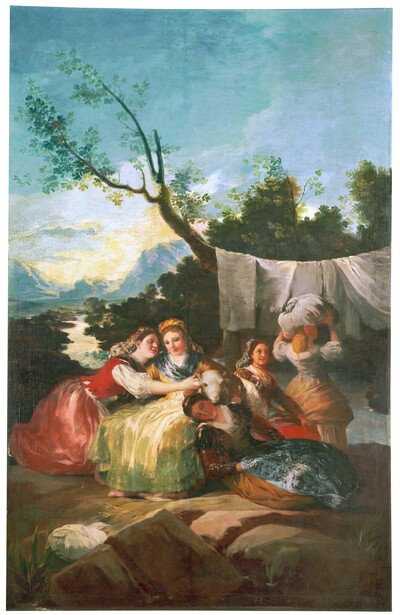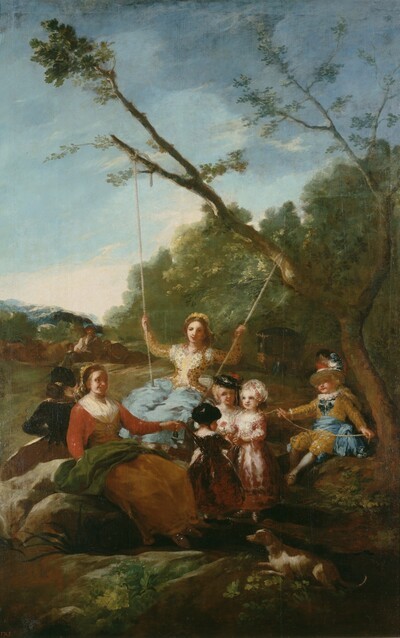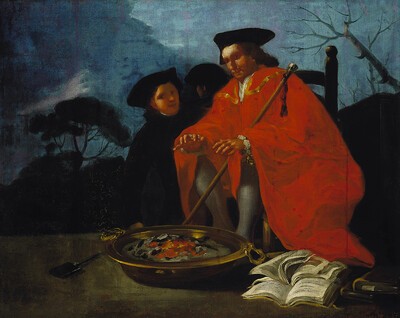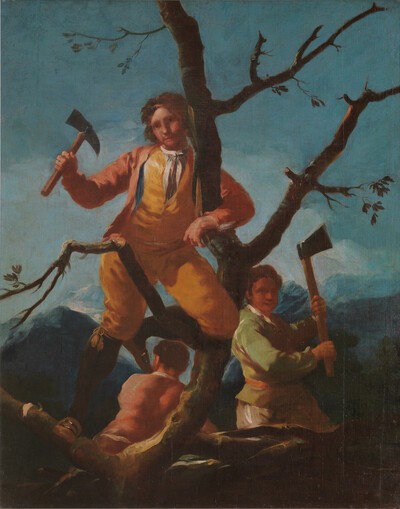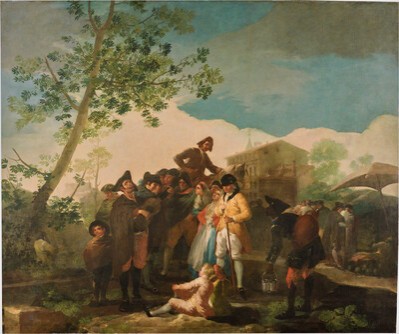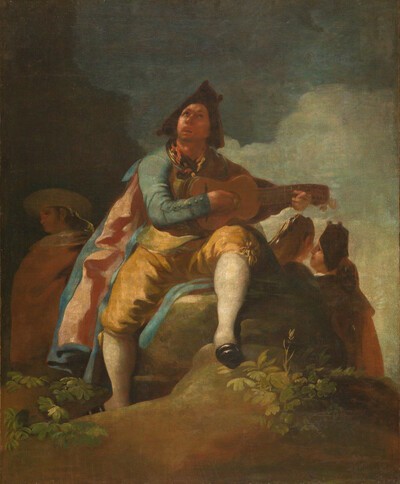- Cronología
- 1779 - 1780
- Ubicación
- The Prado National Museum. Madrid, Madrid, Spain
- Dimensiones
- 262 x 40 cm
- Técnica y soporte
- Oil on canvas
- Reconocimiento de la autoría de Goya
- Documented work
- Titular
- El Prado National Museum
- Ficha: realización/revisión
- 30 Nov 2009 / 14 Jun 2023
- Inventario
- (P00789)
See The Blind Guitarist.
This cartoon was delivered to the Royal Tapestry Factory on 24 January 1780, along with ten other cartoons, completing the decoration of the antechamber to the bedroom. These eleven tapestry cartoons - almost certain to have been made between 21 July 1779, when the artist delivered A Stickball Game and The Swing, and this delivery in January 1780 - were executed very rapidly. It is very likely that Goya was aware of the planned suspension of manufacturing work at the factory and was anxious to finish his commissions and receive his wages.
Around 1856 or 1857, the cartoon was moved from the Royal Tapestry Factory of Santa Bárbara to the Royal Palace in Madrid. In 1870, it was taken to the Prado Museum under orders given on 18 January and 9 February.
This narrow corner-piece decorated the north wall of the bedroom antechamber, where it formed a pair with another corner-piece, Boy with a Bird.
At the foot of the tree, the element that marks the vertical axis of the composition and which fills almost its entire height, we see the boy reaching up to grasp one of the branches, albeit with a somewhat less than convincing leap. Behind him we see another boy, waiting with a basket.
If we follow Tomlinson's theory, the boy is attempting to steal the eggs from a nest that would be on a branch of the tree that is not visible from the viewer's standpoint. And, as she reminds us, the egg is the symbol of female virtue, thereby placing this work in context with the rest of the tapestries decorating the north wall.
Nordström, on the other hand, believes that this piece, its companion corner-piece, The Washerwomen, and The Woodcutters are all related to springtime and impulsiveness.
-
Goya. 250 AniversarioMuseo Nacional del PradoMadrid1996consultant editor Juan J. Luna. From March 29th to June 2nd 1996cat. 29
-
Goya en Madrid. Cartones para tapices 1775-1794Museo Nacional del PradoMadrid2014p. 210
-
L'œuvre peint de Goya. 4 volsParís1928-1950vol. I, p. 84, cat. 25
-
Tapices de GoyaMadridPatrimonio Nacional1946p. 240, cat. 35 y lám. 131
-
Vie et ouvre de Francisco de GoyaParísOffice du livre1970pp. 76, 89, cat. 138
-
BarcelonaPolígrafa1970vol. I, p. 248, cat. 89
-
L’opera pittorica completa di GoyaMilanRizzoli1974pp. 95-96, cat. 96
-
Francisco de Goya, 4 vols.ZaragozaCaja de Ahorros de Zaragoza, Aragón y Rioja1980-1982vol. I, p. 114
-
Francisco de Goya, cartones y tapicescol. col. "Espasa Arte"Espasa Calpe1987pp. 108, 280, cat. 39C
-
Francisco de Goya. Los cartones para tapices y los comienzos de su carrera en la corte de Madridcol. col. "Ensayos de Arte Cátedra"MadridCátedra1987pp. 147 y p. 148 (il.)
-
Goya. 250 AniversarioMadridMuseo del Prado1996pp. 309-310, cat. 29 y p. 105 (il.)
-
Salas del Palacio Real de El Pardo para las que se tejieron tapices sobre cartones de Francisco de Goya: identificación de las habitaciones y ajuste de las obras de Goya en los alzados de las paredesin HERRERO CARRETERO, Concha (curator, Tapices y cartones de Goya (catalogue of the exhibition organizated at the Palacio Real de Madrid, from may to june 1996)MadridPatrimonio Nacional, Goya 96, Lunwerg1996p. 169 (il.)
-
Goya en Madrid. Cartones para tapices 1775-1794MadridMuseo Nacional del Prado2014p. 210

